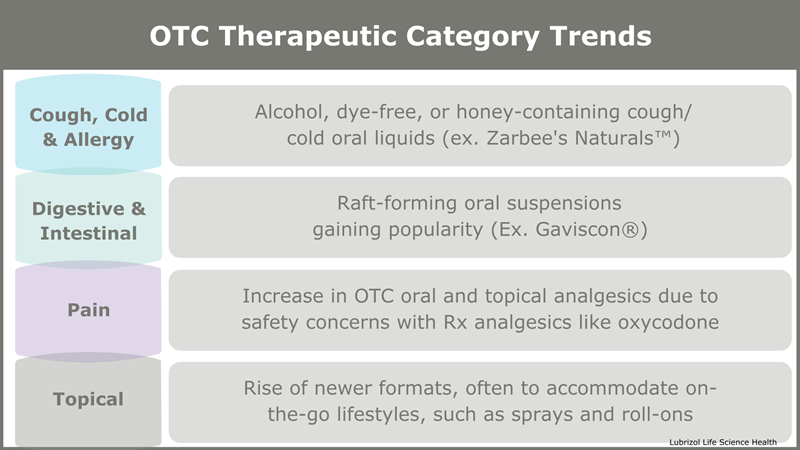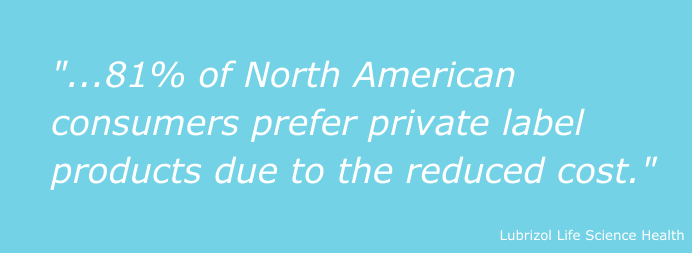Generally, over-the-counter (OTC) drug products are medications considered safe to use without the explicit permission of a medical professional. OTC products are often available on shelves in pharmacies, grocery stores, and sometimes even in gas stations. The exact definition of an OTC product can vary on a country-to-country basis.
OTC medicines treat and alleviate the symptoms of many common ailments, such as pain, cold and flu, heartburn, and acne. Product examples include cough suppressants, analgesics (pain relievers), and antihistamines. In this post, Lubrizol Life Science Health (LLS Health) dives further into OTC classification, trends in the space, and the market outlook.
What therapeutic areas typically fall under OTC treatments?
There are endless disorders and injuries treatable with OTC drugs, but products can often be grouped into the following therapeutic categories:
- Cough, Cold & Allergy
- Digestive & Intestinal Ailments
- Pain
- Topical Disorders (i.e., Dermal, Vaginal, Ophthalmic, etc.)
These treatments come in various formats, mainly oral solids (tablets, capsules, and lozenges), oral liquids, topicals, and films/patches.

Figure 1: Select Trends in OTC by Therapeutic Category
How are OTC products regulated?
In most countries, applicable regulatory requirements ensure that OTC products contain ingredients safe and effective for use without a physician’s prescription. There are typically different classes of OTC products, such as those accessible on store shelves versus located behind a pharmacy counter.
In the latter scenario, products usually must be handed to a consumer by a registered pharmacist. Pharmacies sometimes provide specific info on a product upon sale and ask the consumer pre-determined questions. They may also require an ID to approve the purchase of the product or enforce certain purchase quantity restrictions. What products fall under each designation differs from country to country.
The regulatory agency responsible for OTC products depends on the country or region. For example, in the United States, the FDA oversees OTC drug products and the process in the US is often monograph-driven. OTC monographs are “recipe books” that establish conditions such as acceptable active ingredients, usages, doses, routes of administration, product labeling, and testing.
There are more than 80 therapeutic category monographs in the US. For example, there are separate monographs for antacids, analgesics, and antihistamines. However, it is important to note that the US monograph process is under reform. The CARES Act was signed into law in March 2020. The act includes legislation that is modernizing the way OTC drugs are regulated in the United States.
Following the US, China and Germany are the largest national markets for OTC products. In the European Union (EU), of which Germany is a member, the European Medicines Agency evaluates most prescription drugs. OTC drugs, however, are reviewed on a national level. Germany’s regulatory body responsible for OTC regulation is the Federal Ministry of Health. In China, the National Medical Products Administration (NMPA) regulates OTC medicines. NMPA was previously known as the China Food and Drug Administration.
Further discussion is beyond the scope of this blog post, as additional regulatory detail varies per nation. However, when developing a drug product, be sure to partner with an organization that understands the regulatory intricacies for your intended region.
What trends are on the rise in OTC products?
Private Label & Online Sales
The percentage of private label OTC product sales in the US increased from 26% in 2009 to 31% in 2018. Private label refers to a product sold under the name of the retailer rather than that of the manufacturer. These products often contain the same or similar ingredients as manufacturer branded products utilizing the same drug and format. Private label products also frequently mimic the manufacturer product in name and packaging style to convey familiarity to consumers.
Stores often sell private label products at lower prices than the manufacturer product, hence their growing popularity with a budget-conscious society. One study reported that 81% of North American consumers prefer private label products due to the reduced cost.
The market share of private label products is expanding in almost all therapeutic categories, including smoking cessation, pain, cough and cold, and gastrointestinal remedies. For example, private label products accounted for nearly two-thirds of smoking cessation patch sales in 2018, and 30% of sleep aid sales.
Also contributing to private label growth, and over-the-counter popularity, is the expansion of OTC sales to online platforms. In the United States, 25% of OTC sales currently occur online. Growth drivers include consumer’s desire for convenience, multiple product options, and the ability to price compare.

Figure 2: Quoted Statistic on OTC Product Preference
Online retail giants like Amazon, which recently launched a private label line called Basic Care, contribute to the trend. Amazon’s private label line comes from a strategic partnership with Perrigo, the largest OTC private label manufacturer in the US.
Basic Care, which consists of 60+ treatments, aligns Amazon to continue to drive growth in private label and OTC online sales. Time will tell if this will lead to Amazon eventually selling prescription drugs; the company is certainly making moves in the healthcare market. In 2018, Amazon announced a joint healthcare venture with JPMorgan Chase and Berkshire Hathaway, the parent company of LLS Health.
Rx-to-OTC Switches
Rx-to-OTC switches are on the upswing in all areas of drug product development. In the past 30 years, the FDA has converted more than 700 prescription (Rx) products to OTC status. This number will only increase.
Global accessibility adds pressure and potential for expanding OTC availability, particularly in the US. Many drugs available only through a prescription in the United States are already available over the counter in other countries. An example would be topical erythromycin, which is Rx in the US but OTC in Belgium and Poland.
The original pharmaceutical applicant often drives the decision to switch an Rx product to OTC. The trend is, therefore, likely the result of new strategies being put in place by Rx marketers. For example, Bayer states in their 2019 Annual Report that part of their strategy is to transition some Rx products suitable for self-care to OTC status.
What is the market outlook for OTC products?
OTC popularity is growing, partially due to rising prescription drug costs and increasing concerns over Rx safety. The uptick in certain disorders, such as those related to stress, pain, and skin conditions, is also a contributing factor. As a result, the outlook for the OTC product market is overall positive. This market, currently estimated at around $125B, is projected to grow at a rate of 4-5% over the next few years.
We expect to see steady innovation in the field of OTC, especially in the United States. The FDA’s current OTC review process is undergoing a complete overhaul, switching from a rulemaking process to one more administrative. Only time will tell how this will affect the number of new OTC products on the market, but there is optimism for it having a positive effect.
Definitively having a positive effect is the rise in private label, online sales, and Rx-to-OTC switches. A recent Rx-to-OTC example that made waves comes from GlaxoSmithKline in the successful switch of Voltaren® to OTC in the US. Voltaren® is a topical anti-inflammatory product containing carbomer as a crucial excipient. In the coming years, we will likely experience Rx-to-OTC switches like this becoming more commonplace, as well as partnerships like Amazon/Perrigo. These factors and more have positioned the OTC space for growth. We’re excited to see how innovators will continue to navigate the changing OTC environment to take on unmet patient needs.
LLS Health continually monitors market growth and consumer trends, such as those in OTC. We respond accordingly by offering patient-centric pharmaceutical ingredients that help meet the needs we observe. Our Carbopol® polymers are efficient carbomer rheology modifiers enabling improved aesthetics and feel, bioadhesion, and easier product administration, among other properties. LLS Health excipients currently add value to numerous commercial OTC products. Contact us today to see how we can make a difference in your formulation.
Author:
Ashley M. Rein | Technical Marketing Specialist


